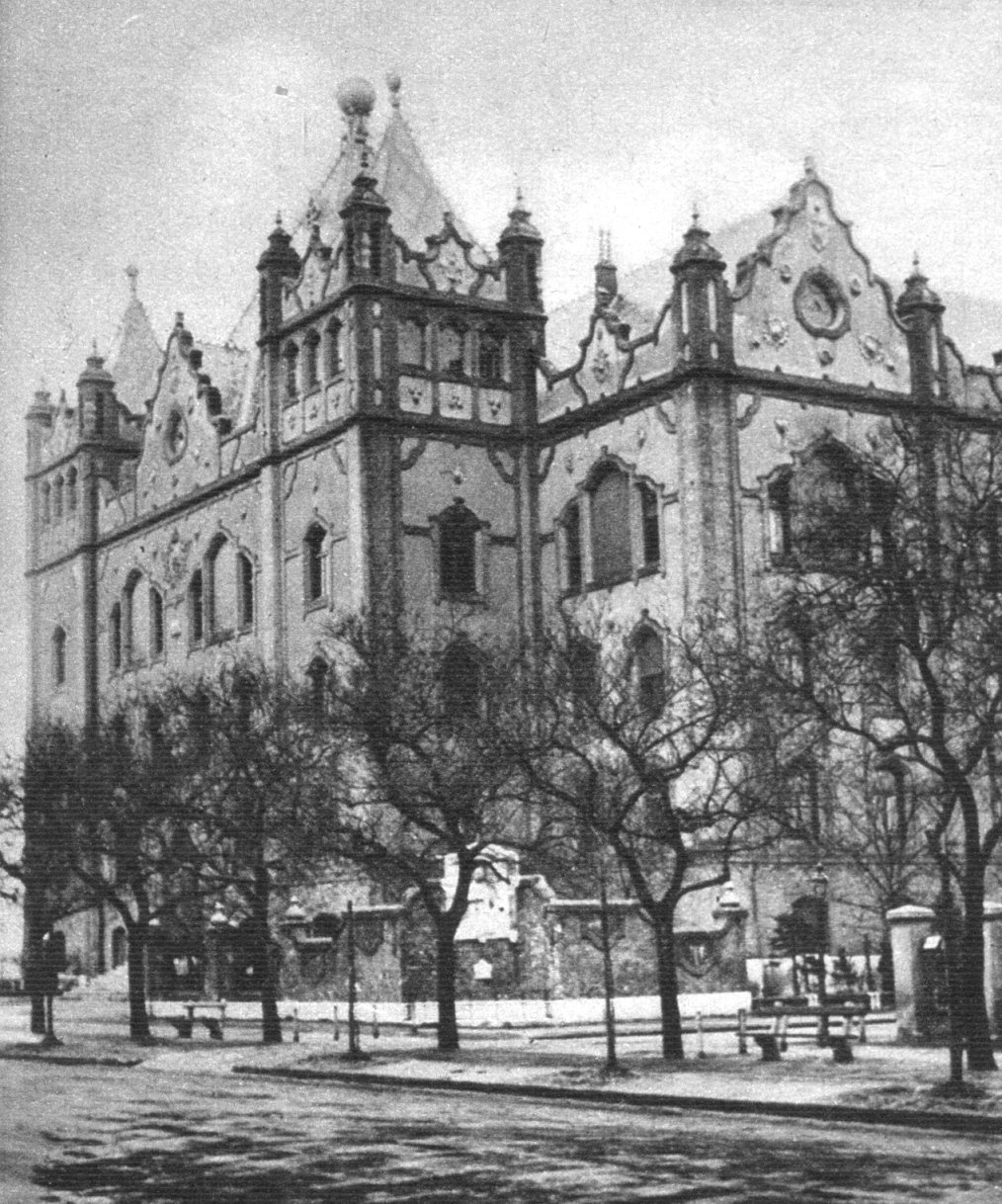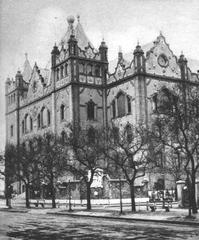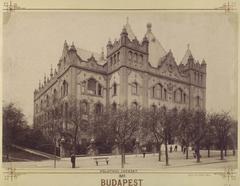
Geological Museum of Budapest: Visiting Hours, Tickets, and Complete Guide to Budapest’s Geological and Historical Marvel
Date: 14/06/2025
Introduction
The Geological Museum of Budapest is a captivating destination that seamlessly blends Hungary’s geological heritage with Art Nouveau architectural grandeur. Founded in 1869 alongside the Hungarian Geological Society, the museum has evolved into a premier institution for scientific research, public education, and cultural enrichment. Its home—a landmark designed by Ödön Lechner, the “Hungarian Gaudí”—embodies national pride and artistic innovation. This comprehensive guide details the museum’s history, collections, visitor information, and nearby attractions, ensuring you make the most of your visit to this Budapest treasure.
Historical and Architectural Significance
Origins and Development
Established during the Austro-Hungarian Empire’s golden age, the Geological Museum of Budapest was inaugurated in 1869 and found its permanent home in a purpose-built structure completed in 1896. This timing coincided with Hungary’s Millennial celebrations, marking a millennium since the Magyar conquest of the Carpathian Basin—a period of intense national pride and cultural achievements (Wikiwand).
Ödön Lechner’s Art Nouveau Masterpiece
Ödön Lechner, a visionary architect, merged European Art Nouveau (Szecesszió) with Hungarian folk motifs and Eastern elements to create a uniquely national style. The museum’s façade is adorned with iridescent Zsolnay ceramic tiles, flowing lines, and a symbolic globe supported by Hungarian figures—iconic features that have made the building a symbol of both scientific endeavor and artistic heritage (We Love Budapest, CNN Travel).
The interior continues the theme with stained glass, intricate woodwork, and folk-inspired motifs. Initially, the building’s avant-garde design sparked debate, but it has since become a celebrated landmark, frequently cited in European architectural history and even considered for UNESCO World Heritage status.
Collections and Scientific Importance
Mineral, Rock, and Fossil Exhibits
The museum houses Hungary’s largest geological collection, with over 180,000 inventoried specimens. Notable highlights include:
- Rare Minerals and Crystals from the Carpathian Basin and beyond.
- Fossils, including prehistoric footprints, Miocene and Pliocene plant and animal remains, and extinct mammals and reptiles.
- Geological Maps and Archival Materials, documenting the history of earth sciences in Hungary.
These collections serve both as educational exhibits and as vital research resources for scientists and students alike (Budapest Tourist Info, Geological Museum Official Site).
Scientific and Educational Role
The museum’s dual function as a public institution and research center is evident in its educational outreach. Interactive exhibitions, workshops, and guided tours make complex geological concepts accessible, while dedicated displays honor the achievements of Hungarian geologists and highlight the country’s scientific legacy.
Visitor Information: Hours, Tickets, and Accessibility
Visiting Hours
- Open: Tuesday to Sunday, 10:00 AM – 6:00 PM
- Closed: Mondays and Hungarian national holidays
It’s advisable to check the official website for up-to-date hours, as these may vary on public holidays or during special events.
Ticket Prices
- Adults: ~1,500 HUF
- Students/Seniors: Discounted rates available
- Children under 6 and visitors with disabilities (plus companion): Free
- Family and Group Tickets: Available
- Budapest Card Holders: Additional discounts may apply
Tickets can be purchased at the entrance or online via the official website. Advance booking is recommended for group visits and special exhibitions.
Accessibility
- Wheelchair Access: Ramps, elevators, and accessible restrooms on all floors
- Assistance: Available upon request
- Languages: Bilingual signage (Hungarian/English), and guided tours in English by prior arrangement
Getting There
The museum is located at Stefánia út 14, District XIV (Zugló)—a short distance from Budapest’s city center.
- Tram: Line 1, “Stefánia út” stop
- Metro: M2 (Red) line, “Stadionok” station, 10–15 min walk
- Bus: Several routes nearby
- Parking: Limited street parking; public transport is recommended (Budapest public transport info)
Exploring the Museum: Layout and Highlights
Exhibitions
- Mineral and Rock Collections: Showcasing Hungary’s geological diversity and unique mineralogy.
- Fossil Galleries: Featuring dinosaur bones, ancient marine life, and prehistoric footprints.
- Hungarian Geology: Interactive displays on volcanic activity, tectonics, and the evolution of the Carpathian Basin.
- Historical Scientific Instruments: Tools used by pioneering Hungarian geologists.
- Temporary Exhibitions: Rotating displays on topics such as climate change, gemstones, and contemporary geological research.
Architectural Features
- Façade and Roof: Zsolnay ceramics, folk motifs, and globe-carrying figures.
- Interior: Stained glass, wood inlay, and cave-like mosaics.
- Lechner Exhibition: Dedicated to the architect’s life and influence on Hungarian Art Nouveau.
Visitor Services and Amenities
- Museum Shop: Souvenirs, educational materials, and mineral samples.
- Café: Light refreshments and drinks.
- Restrooms: Clean and accessible.
- Cloakroom: Free service for coats and bags.
- Wi-Fi: Complimentary throughout the museum.
- Educational Programs: Workshops and activities for schools and families.
Tips for Your Visit
- Allocate 1–2 hours for a comprehensive visit.
- Check for special events or temporary exhibits.
- Photography without flash is allowed in permanent exhibitions.
- Combine your visit with nearby attractions such as City Park, Vajdahunyad Castle, and the Museum of Hungarian Agriculture (City Park info).
- For enhanced experiences, use the Audiala app for guided audio tours.
Frequently Asked Questions (FAQ)
Q: What are the museum’s opening hours?
A: Tuesday to Sunday, 10:00 AM–6:00 PM. Closed Mondays and holidays.
Q: How much are tickets?
A: Adults ~1,500 HUF; discounts for students, seniors, and families. Children under 6 and disabled visitors enter free.
Q: Is the museum accessible?
A: Yes, it offers ramps, elevators, accessible restrooms, and staff assistance.
Q: Are guided tours available?
A: Yes, in both Hungarian and English by prior arrangement.
Q: Can I take photos?
A: Non-flash photography is permitted in permanent exhibits.
Nearby Attractions
- Museum of Applied Arts: Another Art Nouveau gem by Lechner, nearby.
- City Park & Heroes’ Square: Ideal for a day of cultural exploration.
- Local Cafés and Parks: Enjoy Budapest’s vibrant atmosphere between museum visits.
Summary and Call to Action
The Geological Museum of Budapest stands at the crossroads of science, art, and national heritage. Its world-class geological collections, interactive exhibitions, and breathtaking Art Nouveau architecture make it a highlight of any trip to Budapest. Plan ahead by checking current hours and ticket information, and consider enhancing your experience with the Audiala app for audio-guided tours. Make the most of your visit by exploring neighboring sites and engaging with the museum’s educational programs.
For up-to-date details, special events, and online ticketing, visit the official museum website. Stay connected by following the museum and Audiala on social media for the latest news and travel inspiration.
Further Reading and Reliable Sources
- Geological Museum of Budapest on Wikiwand
- 10 Sensational Art Nouveau Buildings in Budapest – We Love Budapest
- Hidden Budapest: Art Nouveau and More – CNN Travel
- Official Website – Geological Museum of Budapest
- Budapest Tourist Info – Geological Museum
- Budapest Public Transport Guide
- City Park – Things to Do in Budapest









































































































































































